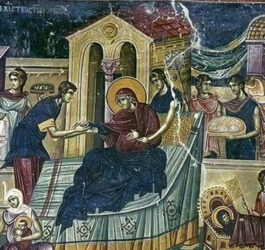by Chris Banescu
Another campaign of stem cell disinformation and misdirection is in full swing in California. The sponsors of Proposition 71, the “California Stem Cell Research and Cures Act,” are promoting a measure that would allow researchers a constitutional right to experiment on embryonic stem cells, and equip them with almost $3 billion in public funds. The drafters of this initiative have cunningly phrased their proposition to purposely avoid using the words “embryo” or “embryonic.” Hoping to obfuscate the real biological issues at hand, supporters of Proposition 71 are deliberately trying to circumvent an honest debate on the issues and legalize research on human embryos without the public’s full understanding of the truth.
On July 8, the California Council of Churches issued a press release titled “California Church IMPACT Endorses Proposition 71.” The announcement touted the measure — slated to appear on the November 2004 ballot — as providing much needed funds and support for “the development of lifesaving therapies and cures for diseases that could save the lives of millions of California children and adults.”
The drafters of this initiative have cunningly phrased their proposition to purposely avoid using the words “embryo” or “embryonic.”
Since the CCC referenced stem cells in general without any clear distinction between embryonic and adult stem cells, my suspicions were immediately raised. While experimentation using adult stem cells is widely regarded as ethical and is supported by most religious institutions, embryonic stem cells research — which requires the destruction of human embryo cells — is much more controversial and is strongly opposed by a vast majority of the conservative religious community. Why was this adult-embryo distinction glossed over?
With the Executive Director of the California Council of Churches, Rev. Dr. Rick Schlosser, throwing his full support behind this measure, it certainly lends an air of legitimacy and authority to Proposition 71. Maybe the kind of stem cells being considered are indeed the adult variety that presented almost no moral controversies. After all, even President George Bush has given his blessing to allow federal funds to be used for research on adult stem cells. Perhaps these religious groups are simply following President Bush’s lead and working to codify the same federal standards already approved and implemented by him in this very field.
Furthermore, Rev. Schlosser’s claim that the CCC represents 1.5 million members of the “mainstream and progressive Protestant and Orthodox communities of faith” further peaked my interest. As an Orthodox Christian, I am aware of the Orthodox Church’s universal opposition to using embryonic tissue for any type of research. Although the word “progressive” is usually a term used by liberal and left-wing organizations to disguise their radical ideologies, the assertion that Orthodox members supported this measure tempered my skepticism. If indeed there were Orthodox organizations that backed Proposition 71, then maybe my reservations and suspicions about this initiative were misguided and unreasonable. With so many religious institutions supporting this measure, why would anyone question the benevolent intent of Proposition 71?
I decided to verify Rev. Schlosser’s claims that Orthodox “communities” supported his group, and visited his website (www.calchurches.org). Sure enough, under the “Member Denominations” section of the California Council of Churches’ site (www.calchurches.org/about_us3.html), listed among other Protestant churches, were two (2) Orthodox Christian organizations: The Greek Orthodox Diocese of San Francisco (linked to www.sf.goarch.org) and the “Orthodox Clergy Council” (not linked, listed at the bottom). Such orthodox credentials seemed to provide additional credibility to Proposition 71 and partially tempered some of my own doubts about the types of stem cells it covered.
Still unclear about the scope of Proposition 71, I proceeded to read the actual wording of the document online (http://www.cirm.ca.gov/pdf/prop71.pdf). Under Section 5 of Article XXXV. Medical Research of Prop. 71 it states:
There is hereby established a right to conduct stem cell research which includes research involving adult stem cells, cord blood stem cells, pluripotent stem cells and/or progenitor cells. Pluripotent stem cells are cells that are capable of self-renewal, and have broad potential to differentiate into multiple adult cell types.
Just what exactly were “pluripotent” cells, and why did the authors of the measure mix both popular and scientific names when describing the various stem cells?
Interestingly enough, while the terms “adult stem cells” and “cord blood stem cells” were clearly identified by their popular names, I was perplexed by the scientifically sounding “pluripotent stem cells” label. Just what exactly were “pluripotent” cells, and why did the authors of the measure mix both popular and scientific names when describing the various stem cells? Was this purely accidental, or was there a more sinister reason for this purposeful obfuscation?
A short journey on Google helped me clarify the term “pluripotent stem cells” and provided a clear and unambiguous answer to this question. The mystery was solved! Pluripotent stem cells can only come from embryonic or fetal tissue. Pluripotent stem cells are otherwise known by their more popular and controversial name: “embryonic stem cells.” Leaving out the popular “embryonic” designation from the wording of the proposition and choosing to use a more confusing and obscure scientific name was not an accident after all. It was a deliberate attempt to hide the truth.
Based on the clear wording of the text of Proposition 71, it will indeed allow researchers to destroy viable human embryos as they see fit. In pursuing this gruesome task, they will have the support of $3 billion in public funds to help them continue their efforts over the next ten years.
Based on the clear wording of the text of Proposition 71, it will indeed allow researchers to destroy viable human embryos as they see fit.
No wonder the sponsors of the measure and their cohorts are deliberately muddying the waters and attempting to confuse the issues. They hope their double-speak will fool the voters into believing this measure is much narrower in scope than it actually is. With most voters solidly opposed to experimentation on viable human embryos, this measure stands little chance of passing. The authors of this initiative are undoubtedly afraid that if the full truth was known, this radical legislation would have little support from the general public. However, by deliberately confusing the issues, hiding behind a little known scientific name, and continually referring only to “stem cells” while purposely leaving out the “embryonic” cells designation, these groups are hoping to quietly legalize a monstrous practice.
Whether the Orthodox organizations listed on the California Council of Churches site are actually aware of the full implications of Proposition 71 or understand that they are being manipulated for maximum affect is still unclear. I seriously doubt that any Orthodox Christian in any position of authority would support such an initiative or have anything to do with a group that is purposely promoting a plan to destroy embryos for science’s sake. Orthodox Christians in California need to sound the alarm within their communities. And Church leaders who are collaborating with Rev. Scholsser’s stem cell campaign should withdraw their support immediately.
It’s time for the backers of Proposition 71 to explain their initiative honestly and openly. That requirement applies all the more obviously for Church leaders, who have dedicated their lives to proclaiming the Truth. California voters deserve nothing less than that.



